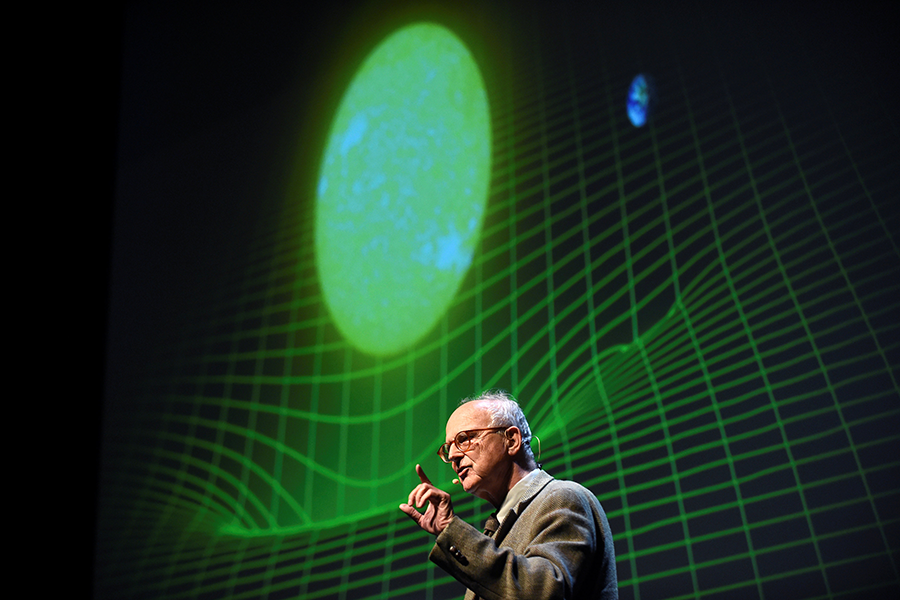A ripple in spacetime: LIGO discovery heralded as breakthrough of 2016
Loading...
More than 100 years ago, in 1915, Albert Einstein predicted that cosmic collisions between massive astronomical bodies would create ripples in spacetime, gravitational waves that could be detected from Earth.
Yet it wasn’t until February 2016 that Einstein’s prediction was confirmed, after twin detectors in Washington and Louisiana detected waves from a collision that occurred 1.3 billion years ago.
The implications of this discovery are wide ranging. Scientists are already preparing to expand their understanding of gravitational waves by examining theories about black holes, and using three new Laser Interferometer Space Antenna (LISA) spacecraft to trace black hole mergers with greater precision.
In opening the door to future research and confirming a more than century-old prediction about the universe, February’s discovery by the Laser Interferometer Gravitational-wave Observatory (LIGO) has proved deserving of the title of the most significant scientific discovery this year, Science magazine announced on Thursday.
“The discovery of gravitational waves has changed the scientific landscape. A new science beckons,” Adrian Cho wrote in a post explaining the magazine's decision to select LIGO’s discovery as the Breakthrough of the Year.
Other candidates included human embryo culture, portable DNA sequencers, and Google’s DeepMind AI’s victory over world Go champion Lee Sedol.
In an online poll conducted by Science, human embryo culture beat LIGO’s discovery by 11 percent. But while online voters may have been more fascinated by human embryo culture, the scientific community is duly impressed by LIGO’s research regarding gravitational waves. February’s discovery won LIGO a $3 million dollar Special Breakthrough Prize earlier this year.
The prize, which was founded and funded by Russian billionaire Yuri Milner and Facebook founder Mark Zuckerberg, among others, was awarded to LIGO scientists in May.
“There are a lot of basic things about Einstein’s theory of relativity that seemed like science fiction when I was a student,” prominent physicist Edward Witten, the head of the physics prize selection committee, said at the time. “This is the first time we’ve seen the full force of Einstein’s theory of gravity at work.”
The gravitational waves "originated during the split second when two black holes, which form when a massive star collapses in upon itself, collided and merged into one, after orbiting each other in a gravitational dance for billions of years," The Christian Science Monitor’s Lonnie Shehktman wrote in February, after scientists announced their September discovery:
The power of the brief collision was massive: 50 times greater than all of the power of all the stars in the universe put together. This caused gravitational ripples, like the water ripples formed when a pebble is dropped into a pond, to “propagate towards Earth carrying the news of the collision,” as Kip Thorne, a theoretical physicist at the California Institute of Technology, said today at a highly anticipated press briefing in Washington, DC, where giddy scientists relayed their findings to a room packed with people and 90,000 others watching online.
The road to discovery was slow. After Einstein’s prediction in 1915, astronomers determined that black hole collisions could create even stronger gravitational waves than he had imagined. In 1972, MIT scientist Rainer Weiss created the interferometer, a device used to detect gravitational waves.
Now, scientists hope to use gravitational waves to better understand the universe. Science magazine reports that LIGO has already identified at least two black hole collisions, and physicists hope to someday detect as many as one black hole merger per day.
LIGO isn’t the only player in the game: other interferometers in Italy, Japan, and India will soon work to detect gravitational waves. In America, some scientists are looking to the stars – pulsar stars – to gain an even clearer picture of cosmic events using LISA detectors.
Science's Mr. Cho writes:
From those waves, LISA could track the mergers of smaller supermassive black holes with much greater precision than pulsar timing. It should be able to spot the long, slow windup of two black holes spiraling together before ground-based instruments like LIGO see the crashing finale. LISA could also detect stellar mass black holes falling into the supermassive black hole in the center of our Milky Way galaxy, enabling physicists to study that behemoth in great detail.
February’s discovery was big – universe shaking, even. Yet it is the implications for future study that make LIGO’s work on gravitational waves the most groundbreaking scientific discovery this year.






